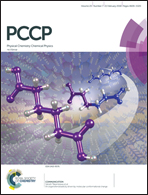Characterization of the binding interactions between EvaGreen dye and dsDNA†
Abstract
Understanding the dsDNA·EG binding interaction is important because the EvaGreen (EG) dye is increasingly used in real-time quantitative polymerase chain reaction, high resolution melting analysis, and routine quantification of DNA. In this work, a binding isotherm for the interactions of EG with duplex DNA (poly-dA17·poly-dT17) has been determined from the absorption and fluorescence spectra of the EG and dsDNA·EG complex. The isotherm has a sigmoidal shape and can be modeled with the Hill equation, indicating positive cooperativity for the binding interaction. A Scatchard plot of the binding data yields a concave-down curve in agreement with the Hill analysis of the binding isotherm for a positive cooperative binding interaction. Analysis of the Scatchard plot with the modified McGhee and von Hippel model for a finite one-dimensional homogeneous lattice and nonspecific binding of ligands to duplex DNA yields the intrinsic binding constant, the number of lattice sites occluded by a bound ligand, and the cooperativity parameter of 3.6 × 105 M−1, 4.0, and 8.1, respectively. The occluded site size of 4 indicates that moieties of the EG intercalate into the adjacent base pairs of the duplex DNA with a gap of 1 intercalation site between EG binding sites, as expected for a bifunctional molecule. Interestingly, at high [EG]/[base pair], the intercalation is disrupted. A model is proposed based on the fluorescence spectrum where the formation of anti-parallel stacked chains of EGs bound externally to the duplex DNA occur at these high ratios.



 Please wait while we load your content...
Please wait while we load your content...